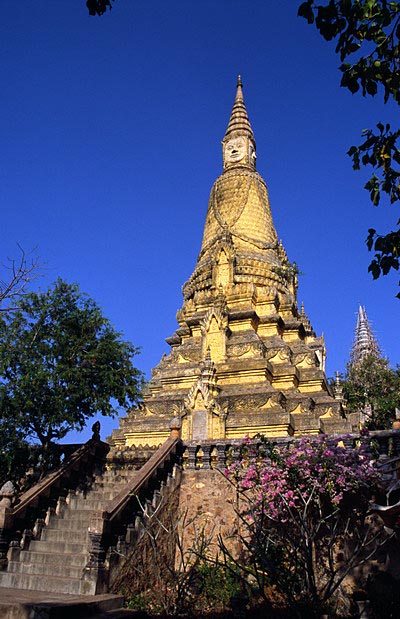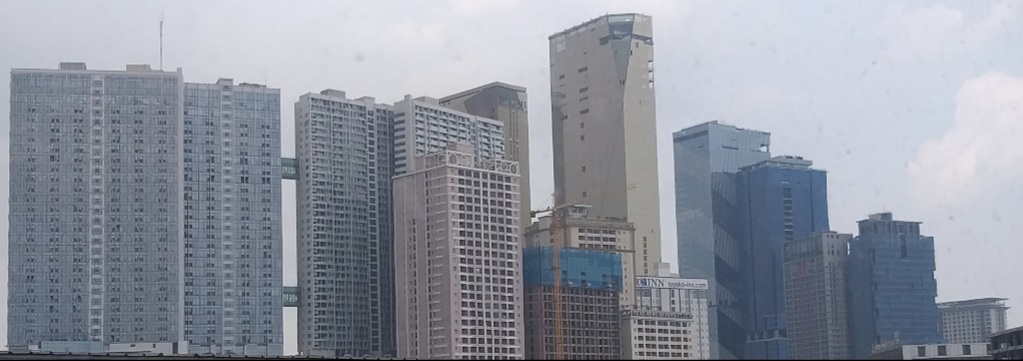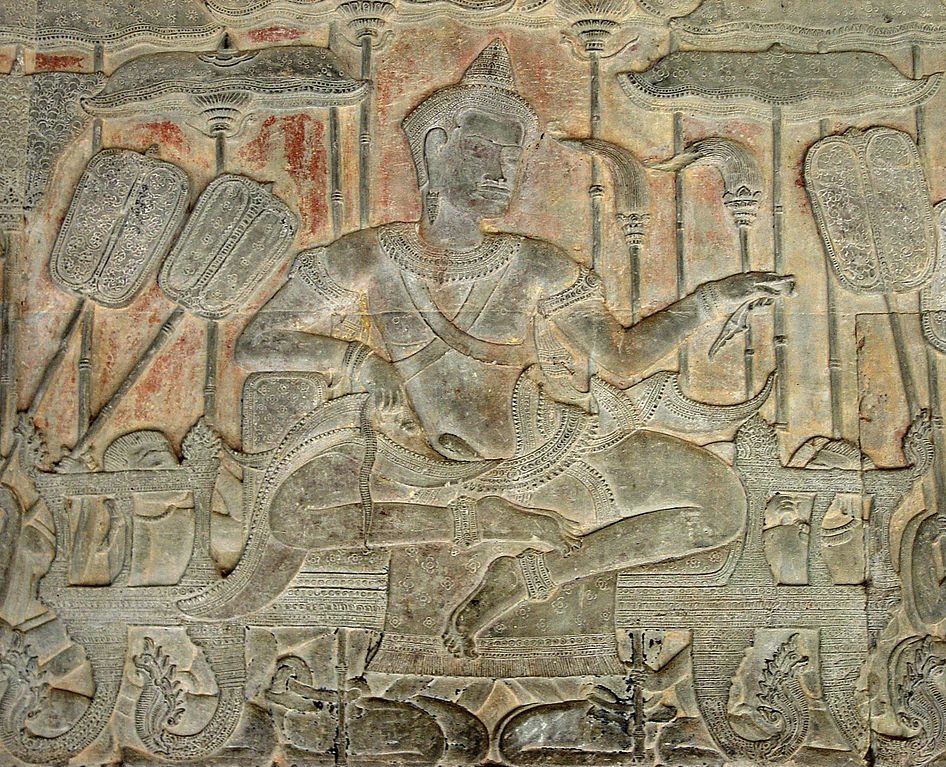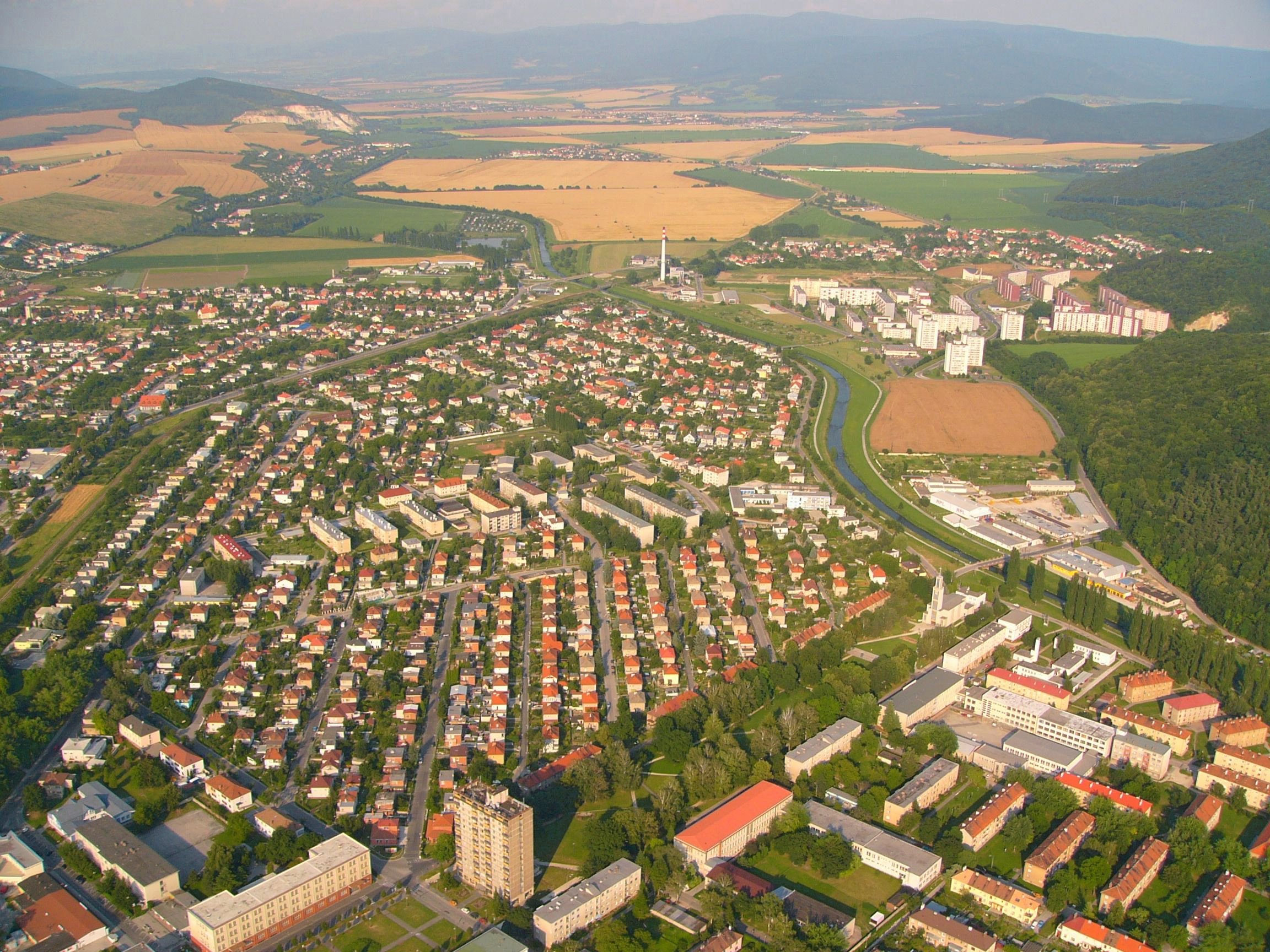|
History Of Cambodia
The history of Cambodia, a country in mainland Southeast Asia, can be traced back to Indian civilization. Detailed records of a political structure on the territory of what is now Cambodia first appear in Chinese annals in reference to Funan, a polity that encompassed the southernmost part of the Indochinese peninsula during the 1st to 6th centuries. Centered at the lower Mekong, Funan is noted as the oldest regional Hindu culture, which suggests prolonged socio-economic interaction with maritime trading partners of the Indosphere in the west. By the 6th century a civilization, called Chenla or Zhenla in Chinese annals, firmly replaced Funan, as it controlled larger, more undulating areas of Indochina and maintained more than a singular centre of power. The Khmer Empire was established by the early 9th century. Sources refer here to a mythical initiation and consecration ceremony to claim political legitimacy by founder Jayavarman II at Mount Kulen (Mount Mahendra) in 802 CE. ... [...More Info...] [...Related Items...] OR: [Wikipedia] [Google] [Baidu] |
Indochina
Mainland Southeast Asia, also known as the Indochinese Peninsula or Indochina, is the continental portion of Southeast Asia. It lies east of the Indian subcontinent and south of Mainland China and is bordered by the Indian Ocean to the west and the Pacific Ocean to the east. It includes the countries of Cambodia, Laos, Myanmar, Thailand and Vietnam, with peninsular Malaysia sometimes also being included. The term Indochina (originally Indo-China) was coined in the early nineteenth century, emphasizing the historical cultural influence of culture of India, Indian and Chinese culture, Chinese civilizations on the area. The term was later adopted as the name of the colony of French Indochina (today's Cambodia, Laos, and Vietnam). Today, the term, Mainland Southeast Asia, in contrast to Maritime Southeast Asia, is more commonly referenced. Terminology The origins of the name Indo-China are usually attributed jointly to the Danish-French geographer Conrad Malte-Brun, who referred ... [...More Info...] [...Related Items...] OR: [Wikipedia] [Google] [Baidu] |
Agriculture
Agriculture or farming is the practice of cultivating plants and livestock. Agriculture was the key development in the rise of sedentary human civilization, whereby farming of domesticated species created food surpluses that enabled people to live in cities. The history of agriculture began thousands of years ago. After gathering wild grains beginning at least 105,000 years ago, nascent farmers began to plant them around 11,500 years ago. Sheep, goats, pigs and cattle were domesticated over 10,000 years ago. Plants were independently cultivated in at least 11 regions of the world. Industrial agriculture based on large-scale monoculture in the twentieth century came to dominate agricultural output, though about 2 billion people still depended on subsistence agriculture. The major agricultural products can be broadly grouped into foods, fibers, fuels, and raw materials (such as rubber). Food classes include cereals ( grains), vegetables, fruits, cooking oils, m ... [...More Info...] [...Related Items...] OR: [Wikipedia] [Google] [Baidu] |
Muslim
Muslims ( ar, المسلمون, , ) are people who adhere to Islam, a monotheistic religion belonging to the Abrahamic tradition. They consider the Quran, the foundational religious text of Islam, to be the verbatim word of the God of Abraham (or ''Allah'') as it was revealed to Muhammad, the main Islamic prophet. The majority of Muslims also follow the teachings and practices of Muhammad (''sunnah'') as recorded in traditional accounts ('' hadith''). With an estimated population of almost 1.9 billion followers as of 2020 year estimation, Muslims comprise more than 24.9% of the world's total population. In descending order, the percentage of people who identify as Muslims on each continental landmass stands at: 45% of Africa, 25% of Asia and Oceania (collectively), 6% of Europe, and 1% of the Americas. Additionally, in subdivided geographical regions, the figure stands at: 91% of the Middle East–North Africa, 90% of Central Asia, 65% of the Caucasus, 42% of South ... [...More Info...] [...Related Items...] OR: [Wikipedia] [Google] [Baidu] |
Indian Ocean Trade
Indian Ocean trade has been a key factor in East–West exchanges throughout history. Long-distance trade in dhows and proas made it a dynamic zone of interaction between peoples, cultures, and civilizations stretching from Southeast Asia to East and Southeast Africa and East Mediterranean in the West in prehistoric and early historic periods. Cities and states on the Indian Ocean rim focused on both the sea and the land. Early period There was an extensive maritime trade network operating between the Harappan and Mesopotamian civilizations as early as the middle Harappan Phase (2600-1900 BCE), with much commerce being handled by "middlemen merchants from Dilmun" (modern Bahrain and Failaka located in the Persian Gulf). Such long-distance sea trade became feasible with the development of plank-built watercraft, equipped with a single central mast supporting a sail of woven rushes or cloth. Several coastal settlements like Sotkagen-dor (astride Dasht River, north of Jiwa ... [...More Info...] [...Related Items...] OR: [Wikipedia] [Google] [Baidu] |
Oudong
( km, ឧដុង្គ; also romanized as Udong or Odong) is a former town of the post-Angkorian period (1618–1863) situated in present-day ''Phsar Daek'' Commune, Ponhea Lueu District, Kandal Province, Cambodia. Located at the foothill of the mountain Phnom Oudong, also known as Phnom Preah Reach Troap ( km, ភ្នំព្រះរាជ្យទ្រព្យ), about 35 km northwest of the modern capital Phnom Penh via National Road No. 5, Oudong was a royal residence and Cambodia's capital for almost 250 years until 1866. A monumental royal necropolis of sovereigns of several centuries is scattered on top of the prominent bisected mountain, which runs from the southeast to the northeast. Etymology The city's name is derived from the Sanskrit word "" ( sa, उत्तुङ्ग), meaning tall, which probably refers to the mountain. As it had gained religious merit and significance it might have undergone extension towards: "great" or "supreme". History Oudong wa ... [...More Info...] [...Related Items...] OR: [Wikipedia] [Google] [Baidu] |
Longvek
Longvek or Lavek ( km, លង្វែក, or , ; meaning "intersection" or "crossroads") was a city in Cambodia. It was the second capital city during the Cambodia's Post-Angkor period which began after the Angkor era. The city was known to early European traders as "Cambodia". The city used to serve as a center of the country's military. It was a gathering point for people of knowledge including scholars and martial artists. Longvek was chosen by King Ang Chan I after the sacking of Angkor by the Siamese as a new capital because of its more readily defensible terrain. As a result, there was a time when Cambodia was often referred to as Longvek by foreign travellers. It was considered one of the greatest cities in Cambodia. After Ang Chan I defeated Sdach Korn he moved the capital city from Chaktomuk to Longvek in 1528. This new city was the capital of the Kingdom of Cambodia from 1528 to 1594. King Ang Chan I ordered his palace to be built in Longvek in 1553. History Durin ... [...More Info...] [...Related Items...] OR: [Wikipedia] [Google] [Baidu] |
Phnom Penh
Phnom Penh (; km, ភ្នំពេញ, ) is the capital and most populous city of Cambodia. It has been the national capital since the French protectorate of Cambodia and has grown to become the nation's primate city and its economic, industrial, and cultural centre. Phnom Penh succeeded Angkor Thom as the capital of the Khmer nation but was abandoned several times before being reestablished in 1865 by King Norodom. The city formerly functioned as a processing center, with textiles, pharmaceuticals, machine manufacturing, and rice milling. Its chief assets, however, were cultural. Institutions of higher learning included the Royal University of Phnom Penh (established in 1960 as Royal Khmer University), with schools of engineering, fine arts, technology, and agricultural sciences, the latter at Chamkar Daung, a suburb. Also located in Phnom Penh were the Royal University of Agronomic Sciences and the Agricultural School of Prek Leap. The city was nicknamed the "Pearl of ... [...More Info...] [...Related Items...] OR: [Wikipedia] [Google] [Baidu] |
Mekong
The Mekong or Mekong River is a trans-boundary river in East Asia and Southeast Asia. It is the world's twelfth longest river and the third longest in Asia. Its estimated length is , and it drains an area of , discharging of water annually. From the Tibetan Plateau the river runs through China, Myanmar, Laos, Thailand, Cambodia, and Vietnam. The extreme seasonal variations in flow and the presence of rapids and waterfalls in the Mekong make navigation difficult. Even so, the river is a major trade route between western China and Southeast Asia. Names The Mekong was originally called ''Mae Nam Khong'' from a contracted form of Tai shortened to ''Mae Khong''. In Thai and Lao, ''Mae Nam'' ("Mother of Water ) is used for large rivers and ''Khong'' is the proper name referred to as "River Khong". However, ''Khong'' is an archaic word meaning "river", loaned from Austroasiatic languages, such as Vietnamese ''sông'' (from *''krong'') and Mon ''kruŋ'' "river", which led to Chine ... [...More Info...] [...Related Items...] OR: [Wikipedia] [Google] [Baidu] |
Angkor Wat
Angkor Wat (; km, អង្គរវត្ត, "City/Capital of Temples") is a temple complex in Cambodia and is the largest religious monument in the world, on a site measuring . Originally constructed as a Hindu temple dedicated to the god Vishnu for the Khmer Empire by King Suryavarman II, it was gradually transformed into a Buddhist temple towards the end of the 12th century; as such, it is also described as a "Hindu-Buddhist" temple. Angkor Wat was built at the behest of the Khmer King Suryavarman II in the early 12th century in Yaśodharapura ( km, យសោធរបុរៈ, present-day Angkor), the capital of the Khmer Empire, as his state temple and eventual mausoleum. Angkor Wat combines two basic plans of Khmer temple architecture: the temple-mountain and the later galleried temple. It is designed to represent Mount Meru, home of the devas in Hindu mythology: within a moat more than 5 kilometres (3 mi) long and an outer wall long are three rectan ... [...More Info...] [...Related Items...] OR: [Wikipedia] [Google] [Baidu] |
Post-Angkor Period
The post-Angkor period of Cambodia ( km, ប្រទេសកម្ពុជាក្រោយសម័យអង្គរ), also called the Middle Period and Dark Age ( km, យុគ្គអន្ធកាល, lit=Isolationism, link=yes; ( km, ភាពឯកោ, lit=Loneliness, link=no); ( km, ភាពវឹកវរ, lit=Vigilantism, link=no)), refers to the historical era from the early 15th century to 1863, the beginning of the French protectorate of Cambodia. As reliable sources (for the 15th and 16th centuries, in particular) are very rare, a defensible and conclusive explanation that relates to concrete events that manifest the decline of the Khmer Empire, recognised unanimously by the scientific community, has so far not been produced. However, most modern historians have approached a consensus in which several distinct and gradual changes of religious, dynastic, administrative and military nature, environmental problems and ecological imbalance coincided with shifts ... [...More Info...] [...Related Items...] OR: [Wikipedia] [Google] [Baidu] |
World History Encyclopedia
World History Encyclopedia (formerly Ancient History Encyclopedia) is a nonprofit educational company created in 2009 by Jan van der Crabben. The organization publishes and maintains articles, images, videos, podcasts, and interactive educational tools related to history. All users may contribute content to the site, although submissions are reviewed by an editorial team before publication. In 2021, the organization was renamed from the Ancient History Encyclopedia to World History Encyclopedia to reflect its broadened scope, covering world history from all time periods, as opposed to just ancient history. Original articles are written in English and later translated into other languages, mainly French and Spanish. Organization history The Ancient History Encyclopedia was founded in 2009 by van der Crabben with the stated goal of improving history education worldwide by creating a freely accessible and reliable history source. The nonprofit organization is based in Godalming, Uni ... [...More Info...] [...Related Items...] OR: [Wikipedia] [Google] [Baidu] |
Urban Planning
Urban planning, also known as town planning, city planning, regional planning, or rural planning, is a technical and political process that is focused on the development and design of land use and the built environment, including air, water, and the infrastructure passing into and out of urban areas, such as transportation, communications, and distribution networks and their accessibility. Traditionally, urban planning followed a top-down approach in master planning the physical layout of human settlements. The primary concern was the public welfare, which included considerations of efficiency, sanitation, protection and use of the environment, as well as effects of the master plans on the social and economic activities. Over time, urban planning has adopted a focus on the social and environmental bottom-lines that focus on planning as a tool to improve the health and well-being of people while maintaining sustainability standards. Sustainable development was added as one ... [...More Info...] [...Related Items...] OR: [Wikipedia] [Google] [Baidu] |










